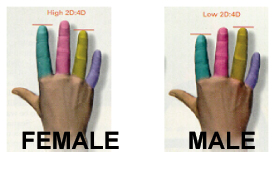|
DEPARTMENT OF ANTHROPOLOGY- HUMAN BEHAVIOR RESEARCH | face and body
|
|
Second to fourth digit ratio, testosterone and perceived male dominance Nick
Neave*, Sarah Laing*, Bernhard Fink** *Human
Cognitive Neuroscience Unit, School of Psychology and Sport Sciences,
Northumbria University, Newcastle upon Tyne, UK |
|
 |
Previous studies have shown that male faces with extreme features associated with testosterone are perceived as dominant and masculine. Women have been reported to prefer more masculinized male faces as they may consider testosterone markers to be an 'honest' indication of good health, and such considerations may underlie their aesthetic preferences. However, pronounced testosterone facial markers are also associated with dominance, and several negative personality traits. This suggests that female aesthetic preferences may be an adaptive compromise between positive attributes associated with higher than average testosterone, and negative attributes associated with more extreme masculinization. This current study attempts to clarify the role of hormone markers in female perceptions of dominance, masculinity and attractiveness, in male facial images. Recent evidence suggests that the relative length of the 2nd to 4th finger (2D : 4D ratio) is a pointer to prenatal testosterone levels and may thus serve as a window to the prenatal hormonal environment. We measured 2D : 4D in a sample of male college students and took salivary samples to analyse circulating levels of testosterone. Women rated facial images of these males for dominance, masculinity and attractiveness. Our results show that male 2D : 4D was significantly negatively related to perceived dominance and masculinity but not attractiveness. Circulating testosterone levels were not related to dominance, masculinity or attractiveness. These findings suggest that: (i) high prenatal levels of testosterone serve to 'organize' male facial features to subsequently reflect dominance and masculine characteristics presumably activated during puberty; and (ii) attractiveness is not directly related to testosterone levels. We conclude that facial dominance and masculinity reflect a male's perceived status rather than his physical attraction to women.
The original paper has appeared in Proceedings of the Royal Society of London B: Biological Sciences, 270, 2167-2172, and is entitled:
Selected references & further reading:
BAKER, F. (1888). Anthropological notes on the human hand. American Anthropologist, 1, 51-76.
GARN, S. M., BURDI, A. R. & BABLER, W. J. (1975). Early prenatal attainment of adult metacarpal-phalangeal rankings and proportions. American Journal of Physical Anthropology, 43, 327-332.
GESCHWIND, N. & BEHAN, P. (1982). Left-handedness: Associations with immune disease, migraine, and developmental learning disabilties. Proceedings of the National Academy of Sciences, 79, 5097-5100.
GESCHWIND, N. & GALABURDA, A. M. (1985). Cerebral lateralization. Biological mechanisms, associations, and pathology: I. A hypothesis and a program for research. Archives of Neurology, 42(5), 428-59.
GESCHWIND, N. & GALABURDA, A. M. (1987). Cerebral lateralization. Biological mechanisms, associations, and pathology. Cambridge, MA: MIT Press.
MANNING,
J.T. (2002). Digit ratio: a pointer to fertility, behaviour and health.
New Jersey: Rutgers University Press.
MANNING, J. T., BARON-COHEN, S., WHEELWRIGHT, S. & SANDERS, G. (2001). The 2nd to 4th digit ratio and autism. Developental Medicine & Child Neurology, 43(3), 160-164.
MANNING, J. T., SCUTT, D., WILSON, J. & LEWIS-JONES, D. I. (1998). The ratio of 2nd to 4th digit length: a predictor of sperm numbers and concentrations of testosterone, luteinizing hormone and oestrogen. Human Reproduction, 13(11), 3000-3004. BBC News on digit ratio & fertility (Video)
MANNING, J.T., & TAYLOR, R.P. (2001). 2nd to 4th digit ratio and male ability in sport: implications for sexual selection in humans. Evolution and Human Behaviour, 22, 61-69.
MANNING, J. T., TRIVERS, R. L., SINGH, D. & THORNHILL, R. (1999). The mystery of female beauty. Nature, 399(6733), 214-215.
OKTEN, A., KALYONKU, M., & YARIS, N. (2002). The Ratio of Second-and-Fourth Digit Lengths and Congenital Adrenal Hyperplasia due to 21-Hydroxylase Deficiency. Early Human Development, 70, 47-54.
PETERS, M., TAN, U., KANG, Y., TEIXERIA, L., & MANDAL, M. (2002). Sex-specific finger-length patterns linked to behavioral variables across human populations. Perceptual and Motor Skills, 94, 171-181.
PHELPS, V. R. (1952). Relative index finger length as a sex-influenced trait in man. American Journal of Human Genetics, 4, 72-89.
WILLIAMS, J. H. J., GREENHALGH, K. D., & MANNING, J. T. (2003). Second to fourth finger ratio and possible precursors of developmental psychopathology in preschool children. Early Human Development, 72, 57-65.
UNIVERSITY OF VIENNA all rights reserved karl.grammer@univie.ac.at |
|